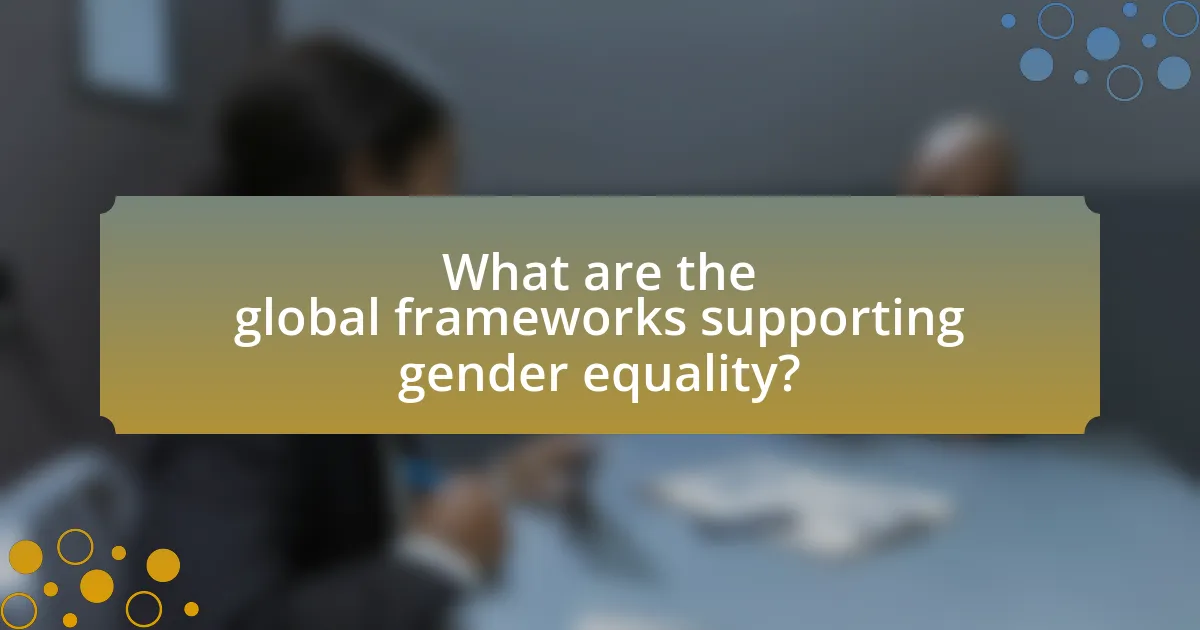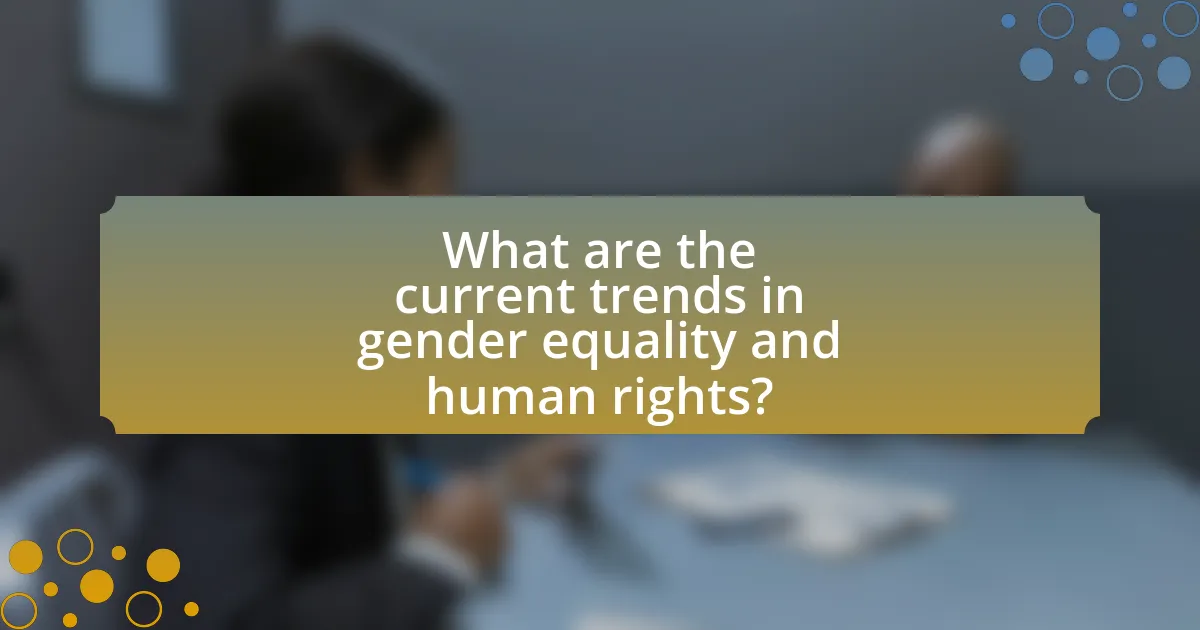Gender equality is defined as the equal rights, responsibilities, and opportunities for individuals regardless of gender, while human rights encompass the fundamental rights and freedoms to which all people are entitled. This article explores the interconnectedness of gender equality and human rights, highlighting historical events that have shaped their understanding, the influence of cultural perspectives, and the implications of gender inequality on society. It also examines global frameworks and treaties that support gender equality, the role of technology and grassroots movements in promoting gender rights, and practical steps individuals can take to advocate for gender equality. The discussion emphasizes the importance of gender equality for sustainable development and social justice, underscoring the need for continued efforts to address systemic discrimination and empower all individuals.

What is Gender Equality and Human Rights?
Gender equality refers to the equal rights, responsibilities, and opportunities of individuals regardless of their gender, while human rights encompass the fundamental rights and freedoms to which all people are entitled. Gender equality is a critical aspect of human rights, as it ensures that individuals can participate fully in society without discrimination based on gender. The United Nations states that achieving gender equality is essential for sustainable development and is a fundamental human right, as outlined in the Universal Declaration of Human Rights.
How are gender equality and human rights interconnected?
Gender equality and human rights are interconnected because gender equality is a fundamental human right that ensures individuals have equal access to opportunities and resources, regardless of gender. This connection is evident in international frameworks such as the Universal Declaration of Human Rights, which emphasizes the importance of equality and non-discrimination. Furthermore, the Convention on the Elimination of All Forms of Discrimination Against Women (CEDAW) specifically addresses gender-based discrimination, reinforcing that achieving gender equality is essential for the realization of human rights for all individuals.
What historical events have shaped the understanding of gender equality?
The suffrage movement, particularly the passage of the 19th Amendment in the United States in 1920, significantly shaped the understanding of gender equality by granting women the right to vote. This event marked a pivotal shift in societal perceptions, emphasizing women’s rights as fundamental human rights. Additionally, the 1960s and 1970s feminist movements, including the publication of Betty Friedan’s “The Feminine Mystique” in 1963, challenged traditional gender roles and advocated for equal opportunities in education and the workplace. The United Nations’ adoption of the Convention on the Elimination of All Forms of Discrimination Against Women (CEDAW) in 1979 further solidified international commitment to gender equality, establishing a framework for addressing discrimination. These events collectively contributed to a broader understanding of gender equality as essential for social justice and human rights.
How do cultural perspectives influence gender equality?
Cultural perspectives significantly influence gender equality by shaping societal norms, values, and expectations regarding gender roles. For instance, in many cultures, traditional beliefs may prioritize male authority and female subservience, which can lead to systemic discrimination against women in areas such as education, employment, and political participation. According to the World Economic Forum’s Global Gender Gap Report 2021, countries with more egalitarian cultural values tend to exhibit smaller gender gaps in economic participation and opportunity. This correlation highlights how cultural attitudes directly impact the realization of gender equality, as societies that embrace gender equity often implement policies that support women’s rights and empowerment.
Why is gender equality important for human rights?
Gender equality is crucial for human rights because it ensures that all individuals, regardless of gender, have equal access to opportunities, resources, and protections under the law. This equality is foundational to the realization of human rights, as it addresses systemic discrimination and promotes social justice. According to the United Nations, gender equality is not only a fundamental human right but also a necessary foundation for a peaceful, prosperous, and sustainable world. Studies show that countries with higher levels of gender equality experience better economic growth and improved health outcomes, demonstrating the interconnectedness of gender equality and the advancement of human rights.
What are the implications of gender inequality on society?
Gender inequality has profound implications on society, leading to economic inefficiencies, social unrest, and hindered development. Economically, gender inequality restricts women’s participation in the workforce, resulting in a loss of potential GDP; for instance, the McKinsey Global Institute estimates that achieving gender parity in labor force participation could add $28 trillion to global GDP by 2025. Socially, gender inequality fosters environments of discrimination and violence, as evidenced by the World Health Organization reporting that one in three women globally experiences physical or sexual violence. Furthermore, gender inequality undermines educational opportunities for girls, perpetuating cycles of poverty and limiting societal progress; UNESCO indicates that if all girls completed secondary education, child marriage rates could drop by 64%. These implications illustrate how gender inequality not only affects individuals but also stifles societal advancement as a whole.
How does gender equality contribute to sustainable development?
Gender equality significantly contributes to sustainable development by promoting inclusive economic growth and social stability. When women have equal access to education, employment, and resources, they can participate fully in the economy, leading to increased productivity and innovation. According to the McKinsey Global Institute, achieving gender equality could add $12 trillion to global GDP by 2025. Furthermore, gender equality enhances decision-making processes, resulting in more effective governance and policies that address the needs of all community members. This holistic approach fosters resilience and sustainability in societies, as diverse perspectives lead to better solutions for environmental and social challenges.

What are the global frameworks supporting gender equality?
The global frameworks supporting gender equality include the Convention on the Elimination of All Forms of Discrimination Against Women (CEDAW), the Beijing Declaration and Platform for Action, and the Sustainable Development Goals (SDGs), particularly Goal 5, which aims to achieve gender equality and empower all women and girls. CEDAW, adopted by the United Nations in 1979, establishes an international bill of rights for women and mandates states to eliminate discrimination against women in all forms. The Beijing Declaration, adopted in 1995, outlines strategic objectives and actions for advancing women’s rights and gender equality globally. The SDGs, established in 2015, provide a comprehensive framework for sustainable development, with Goal 5 specifically addressing the need for gender equality and the empowerment of women and girls, emphasizing the importance of legal frameworks, access to education, and participation in decision-making processes.
How do international treaties promote gender equality?
International treaties promote gender equality by establishing legal frameworks that obligate countries to uphold and protect women’s rights. For instance, the Convention on the Elimination of All Forms of Discrimination Against Women (CEDAW), adopted by the United Nations in 1979, requires signatory states to eliminate discrimination against women in all areas, including political, economic, and social spheres. This treaty has led to significant legislative changes in many countries, such as the introduction of laws aimed at preventing gender-based violence and ensuring equal pay. Additionally, international treaties often provide mechanisms for accountability, allowing for monitoring and reporting on progress, which further encourages nations to prioritize gender equality in their policies and practices.
What role does the United Nations play in advancing gender equality?
The United Nations plays a crucial role in advancing gender equality through its various agencies, initiatives, and frameworks. The UN promotes gender equality by establishing international norms and standards, such as the Convention on the Elimination of All Forms of Discrimination Against Women (CEDAW), which has been ratified by 189 countries, thereby providing a legal framework for gender equality. Additionally, the UN’s Sustainable Development Goals (SDGs), particularly Goal 5, specifically aim to achieve gender equality and empower all women and girls by 2030, highlighting the global commitment to this issue. The UN also conducts research, provides funding, and supports programs that address gender-based violence, economic empowerment, and political participation, further solidifying its role as a leader in promoting gender equality worldwide.
Which key documents outline gender rights globally?
Key documents that outline gender rights globally include the Convention on the Elimination of All Forms of Discrimination Against Women (CEDAW), the Beijing Declaration and Platform for Action, and the Universal Declaration of Human Rights (UDHR). CEDAW, adopted by the United Nations in 1979, specifically addresses discrimination against women and sets an agenda for national action to end such discrimination. The Beijing Declaration, established in 1995, outlines strategic objectives and actions for the advancement of women. The UDHR, adopted in 1948, asserts the fundamental rights of all individuals, including gender equality. These documents collectively serve as foundational frameworks for promoting and protecting gender rights worldwide.
What are the challenges in achieving gender equality worldwide?
Achieving gender equality worldwide faces several significant challenges, including cultural norms, economic disparities, and legal barriers. Cultural norms often perpetuate stereotypes and discrimination against women, limiting their access to education and employment opportunities. Economic disparities manifest in the gender pay gap, where women earn significantly less than men for similar work; for instance, the World Economic Forum reported in 2021 that women globally earn about 68% of what men earn. Legal barriers include inadequate laws protecting women’s rights and insufficient enforcement of existing laws, which can hinder progress toward equality. These challenges collectively impede efforts to create a more equitable society for all genders.
What barriers do women face in different regions?
Women face various barriers in different regions, including legal restrictions, cultural norms, and economic disparities. In many Middle Eastern countries, legal frameworks limit women’s rights in areas such as marriage, divorce, and inheritance, often resulting in unequal treatment under the law. In South Asia, cultural practices like child marriage and gender-based violence hinder women’s access to education and healthcare, perpetuating cycles of poverty. In Sub-Saharan Africa, women often face economic barriers due to limited access to land ownership and financial resources, which restricts their ability to achieve economic independence. According to the World Economic Forum’s Global Gender Gap Report 2021, these disparities contribute to a significant gender gap in economic participation and opportunity, highlighting the systemic nature of these barriers across different regions.
How do economic factors affect gender equality?
Economic factors significantly influence gender equality by determining access to resources, employment opportunities, and income levels for different genders. For instance, countries with higher GDP per capita tend to exhibit greater gender equality, as economic growth often leads to improved access to education and healthcare for women. According to the World Economic Forum’s Global Gender Gap Report, nations that invest in women’s education and workforce participation experience a reduction in gender disparities, demonstrating that economic investment directly correlates with enhanced gender equality. Furthermore, economic downturns often disproportionately affect women, as they are more likely to work in vulnerable sectors, highlighting the critical role of economic stability in promoting gender equality.

What are the current trends in gender equality and human rights?
Current trends in gender equality and human rights include a growing emphasis on intersectionality, increased representation of women in leadership roles, and a focus on addressing gender-based violence. Intersectionality recognizes that individuals experience discrimination differently based on overlapping identities, leading to more inclusive policies. For instance, the United Nations reports that women’s representation in national parliaments has reached an average of 26.1% globally, reflecting progress in political participation. Additionally, initiatives aimed at combating gender-based violence have gained traction, with countries implementing stricter laws and support systems. According to the World Health Organization, 1 in 3 women globally experience physical or sexual violence, highlighting the urgent need for continued efforts in this area.
How is technology influencing gender equality?
Technology is influencing gender equality by providing women with greater access to education, economic opportunities, and platforms for advocacy. For instance, mobile technology has enabled women in developing countries to access online learning resources, which has been shown to increase literacy rates among women by 20% in regions where such technologies are implemented. Additionally, digital platforms allow women entrepreneurs to reach broader markets, with a report from McKinsey indicating that closing the gender gap in labor force participation could add $28 trillion to global GDP by 2025. Furthermore, social media serves as a powerful tool for raising awareness about gender issues, facilitating movements like #MeToo, which has mobilized millions globally to advocate for women’s rights. These examples illustrate how technology acts as a catalyst for advancing gender equality across various sectors.
What are the positive impacts of social media on gender rights?
Social media positively impacts gender rights by amplifying marginalized voices and facilitating awareness campaigns. Platforms like Twitter and Facebook enable individuals and organizations to share experiences of gender discrimination, leading to increased public discourse and advocacy. For instance, the #MeToo movement gained global traction through social media, highlighting sexual harassment and empowering survivors to speak out. Research from the Pew Research Center indicates that 70% of social media users believe these platforms help raise awareness about social issues, including gender equality. This connectivity fosters solidarity and mobilizes support for gender rights initiatives, ultimately contributing to societal change.
How can technology be leveraged to combat gender-based violence?
Technology can be leveraged to combat gender-based violence through the development of mobile applications, online reporting systems, and data analytics. Mobile applications like SafeTrek and Circle of 6 provide users with immediate access to emergency services and support networks, enhancing personal safety. Online reporting systems enable victims to report incidents anonymously, which can increase reporting rates and help authorities respond more effectively. Data analytics can identify patterns of violence, allowing organizations to allocate resources strategically and implement preventive measures. For instance, the use of predictive policing algorithms has shown promise in reducing incidents of violence in certain areas by focusing law enforcement efforts where they are most needed.
What role do grassroots movements play in promoting gender equality?
Grassroots movements play a crucial role in promoting gender equality by mobilizing communities to advocate for women’s rights and challenging systemic inequalities. These movements often emerge from local contexts, allowing them to address specific cultural and social issues that affect gender equality. For instance, organizations like the Women’s March and local initiatives in various countries have successfully raised awareness about gender-based violence and discrimination, leading to policy changes and increased public support for gender equality initiatives. Research shows that grassroots activism can lead to significant legislative reforms; for example, the 2017 Women’s March in the United States galvanized millions and contributed to the election of more women to political office, demonstrating the tangible impact of grassroots efforts on advancing gender equality.
How do local organizations contribute to global gender equality efforts?
Local organizations contribute to global gender equality efforts by implementing grassroots initiatives that address specific community needs and challenges. These organizations often provide education, resources, and support services tailored to local contexts, which can lead to significant improvements in women’s rights and gender equity. For example, in many regions, local NGOs focus on empowering women through vocational training and legal assistance, which directly impacts their economic independence and social status. According to a report by UN Women, local organizations play a crucial role in mobilizing communities, advocating for policy changes, and fostering partnerships that amplify the voices of marginalized groups, thereby enhancing the effectiveness of global gender equality initiatives.
What strategies have proven effective in grassroots advocacy?
Effective strategies in grassroots advocacy include building coalitions, leveraging social media, and engaging in community organizing. Building coalitions allows diverse groups to unite around common goals, enhancing influence and reach. For instance, the Women’s March in 2017 successfully mobilized millions by uniting various organizations and individuals advocating for gender equality and human rights. Leveraging social media enables rapid dissemination of information and mobilization of supporters, as seen in campaigns like #MeToo, which raised awareness about sexual harassment and assault globally. Community organizing fosters local leadership and empowers individuals to advocate for their rights, exemplified by the work of organizations like the National Domestic Workers Alliance, which has effectively organized and advocated for the rights of domestic workers across the United States. These strategies demonstrate the power of collective action and communication in advancing grassroots advocacy efforts.
What practical steps can individuals take to support gender equality?
Individuals can support gender equality by actively promoting equal opportunities in their communities and workplaces. This can be achieved by advocating for policies that ensure equal pay for equal work, as research shows that women earn approximately 82 cents for every dollar earned by men in the United States. Additionally, individuals can participate in or support organizations that focus on women’s rights and gender equality initiatives, such as the United Nations Women, which works to eliminate discrimination against women and girls. Engaging in conversations about gender stereotypes and challenging discriminatory behavior in social settings also contributes to a culture of equality. Furthermore, individuals can educate themselves and others about gender issues, as informed discussions can lead to greater awareness and change.
How can education promote gender equality in communities?
Education can promote gender equality in communities by providing equal access to learning opportunities for all genders, which empowers individuals and fosters social change. When educational institutions implement inclusive curricula that challenge gender stereotypes, they help to reshape societal norms and attitudes. For instance, research from the United Nations Educational, Scientific and Cultural Organization (UNESCO) indicates that educating girls leads to improved economic outcomes and health benefits for entire communities, as educated women are more likely to participate in the workforce and make informed decisions regarding their families. Furthermore, programs that focus on gender-sensitive teaching methods can enhance the learning experience for all students, promoting respect and understanding among different genders.
What actions can individuals take to advocate for gender rights?
Individuals can advocate for gender rights by participating in awareness campaigns and supporting organizations that promote gender equality. Engaging in local and global movements, such as the #MeToo movement, has shown to raise awareness and drive policy changes regarding gender rights. Additionally, individuals can educate themselves and others about gender issues, which is crucial for fostering understanding and support. Research indicates that informed communities are more likely to challenge discriminatory practices and support equitable policies. Furthermore, individuals can contact their representatives to advocate for legislation that protects and promotes gender rights, as demonstrated by the successful passage of laws in various countries following public advocacy efforts.


